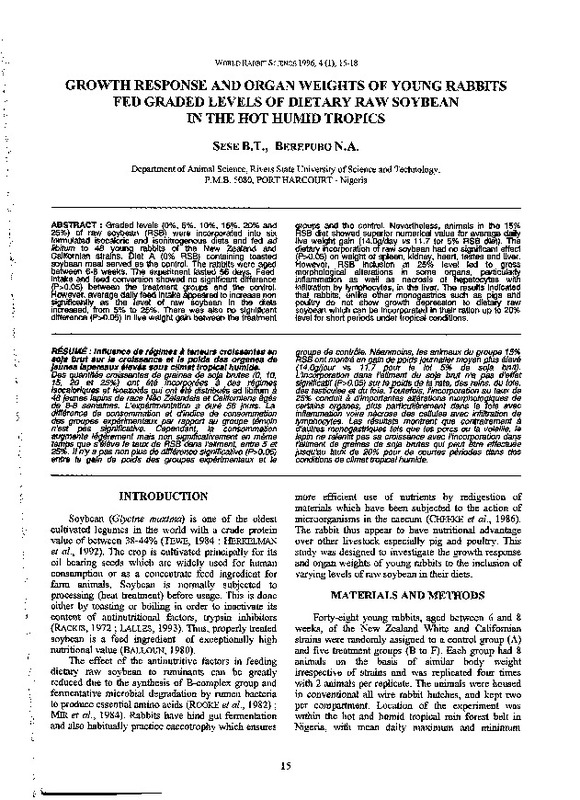JavaScript is disabled for your browser. Some features of this site may not work without it.
Buscar en RiuNet
Listar
Mi cuenta
Estadísticas
Ayuda RiuNet
Admin. UPV
GROWTH RESPONSE AND ORGAN WEIGHTS OF YOUNG RABBITS FED GRADED LEVELS OF DIETARY RAW SOYBEAN IN THE HOT HUMID TROPICS
Mostrar el registro sencillo del ítem
Ficheros en el ítem
| dc.contributor.author | SESE, B.T.
|
|
| dc.contributor.author | BEREPUBO, N.A.
|
|
| dc.date.accessioned | 2011-03-21T12:30:39Z | |
| dc.date.available | 2011-03-21T12:30:39Z | |
| dc.date.issued | 1996 | |
| dc.identifier.issn | 1257-5011 | |
| dc.identifier.uri | http://hdl.handle.net/10251/10476 | |
| dc.description.abstract | [EN] Gradad tevets (0%, 5%, 10%, 15%, 20% and 25%) of raw soybean (RSB) were incorporated into six tormulated isocaloric and isonitrogenous diets and fed ad libitum to 48 young rabbits of the New Zealand and Californian stra1ns. Diet A (0% RSB) containing toasted soybean meal served as the control. The rabbits were aged between 6-8 weeks. The experiment lastad 56 days. Feed intake and feed conversion showed no significant difference (P>0.05) between the treatment groups and the control. However, average daily feed intake appeared to increase non signiflcantty as the level of raw soybean in the diets increased, from 5% to 25%. There was atso no significant difference (P>0.05) in live weight gain between the treatment groups and the control. Nevertheless, animals in the 15% RSB diet showed su13erior numerical value for average daity live weight gain (14.0Q/day vs 11. 7 for 5% RSB diet). The dietary incorporat1on of raw sovbean had no significant effect (P>0.05) on weight of spteen, kidney, heart, testes and liver. However, RSB inctusion at 25% level led to gross morphological alterations in soma organs, particutarty inflammat1on as watt as necrosis of llepat~es with infiltration by tymphocytes, in the liver. The results indicated that rabbits, unlike other monogastrics such as pigs and poultry do not show growth depresslon to dietary raw soybean which can be incorporated in their ration up to 20% level for short periods under tropical conditions. | es_ES |
| dc.description.abstract | [FR] Des Quantités croissantes de graines de soffe brutes (0, 10, 15, 20 et 25%) ont été mcorporées a des régimes isocaloriques et isoazotés QUÍ ont été distribués ad libifum a 48 jeunes Japins de race Neo Zélandais et Califomiens agés de 6-8 semaines. L'expérimentation a duré 56 jours. La différence de consommation et d'indice de consommation des groupes expé_rimentaux _par rapport au groupe témoin n'est pas significative. Cependant la consommation augmente l~erement mais non signfflcativement en m,jme temps que s eleve le taux de RSB dans l'aliment, entre 5 et 25%. JI ny a pa,s non plus de différence significativa (P>0.05) entre le gain de potds des groupes expérimentaux et le groupe de contróle. Néanmoins, les anímaux du groupe 15% RSB ont montré un gain de poids journalier moyen plus élevé [ 14.0g/jour vs 11.7 pour le lot 5% de soja brut). 'incorporation dans l'aliment du soja brut napas d'effet significatíf (P>0.05) sur le poids de la rate, des rems, du foie, des testicules et du foie. Toutefois, l'incorporation au taux de 25% conduít a d'ímportantes altérations morphologiques de certains organes, plus particulierement dans le Jote avec inflammation voire nécrose des ce/Ju/es avec infiltration de ly_mphocytes. Les résultats montrent que contrairement a il'autres monog_astriQues tels que les porcs ou la volaille, le Japin ne ra/ent1t pas sa croissance avec /'incorporation dans l'áliment de grames de soja brotes qui peut 'litre effectuée jusqu'au taux de 20% pour de courtes périodes dans des condítions de climat tropical humide. | |
| dc.language | Inglés | es_ES |
| dc.publisher | World Rabbit Science. ICTA. UPV | es_ES |
| dc.relation.ispartof | World Rabbit Science | |
| dc.rights | Reserva de todos los derechos | es_ES |
| dc.title | GROWTH RESPONSE AND ORGAN WEIGHTS OF YOUNG RABBITS FED GRADED LEVELS OF DIETARY RAW SOYBEAN IN THE HOT HUMID TROPICS | es_ES |
| dc.type | Artículo | es_ES |
| dc.date.updated | 2011-03-21T12:09:16Z | |
| dc.identifier.doi | 10.4995/wrs.1996.264 | es_ES |
| dc.rights.accessRights | Abierto | es_ES |
| dc.description.bibliographicCitation | Sese, B.; Berepubo, N. (1996). GROWTH RESPONSE AND ORGAN WEIGHTS OF YOUNG RABBITS FED GRADED LEVELS OF DIETARY RAW SOYBEAN IN THE HOT HUMID TROPICS. World Rabbit Science. 04(1). https://doi.org/10.4995/wrs.1996.264 | es_ES |
| dc.description.accrualMethod | SWORD | es_ES |
| dc.relation.publisherversion | https://doi.org/10.4995/wrs.1996.264 | es_ES |
| dc.description.volume | 04 | |
| dc.description.issue | 1 | |
| dc.identifier.eissn | 1989-8886 | es_ES |








